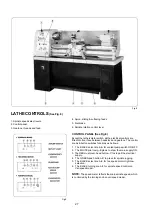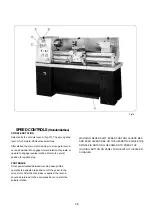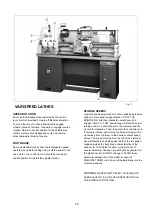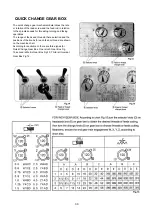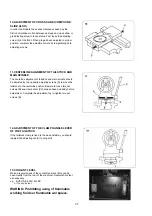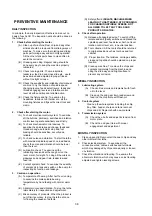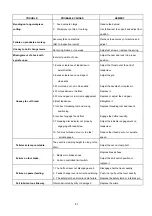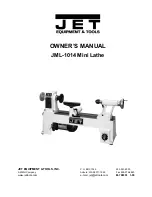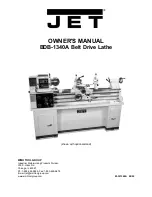
38
PREVENTIVE MAINTENANCE
DAILY INSPECTION
In principle, the daily inspection of lathe is carried out on
basis of each shift. The inspection work should be done as
the following:
1. Check before starting the motor.
(A) Clean up of machine: Dust, chip and any other
articles should be removed from sliding ways of
machine. To make sure the rotating and sliding
parts performing easy and smoothly operation.
All the other static parts have to clean often to
avoid the corrosion.
(B) Greasing and oiling: Regular oiling should be
done every day to keep the machine properly
lubricated.
(C) Check running parts: The main spindle,
leadscrew, feed rod and cross slide etc., would
be examined and adjusted to proper fitness
without too tight or loose.
(D) Check the sensitivity and reliability of all manual
controls: to try the function of spindle speed
changing levers, feeds select levers, feeds and
threads engaging levers and rotation control
lever all with sensitive and reliable action.
(E) Check the fixture and fig: To examine the
headstock, tailstock, tool holder etc., all the
mounting fixtures and figs with correct lock and
clamp.
2. Check after starting the motor.
(A) To check electrical control system: To examine
all the buttons, pilot lamp, switches and rotation
control lever operate sensitively and strictly.
(B) To check mechanical control devices: To
examine the spindle speed change, feeds and
threads change, automatic stop and foot
braking should be sensitive, security and
reliable.
(C) To check noise and vibration: To start the lathe
with maximum spindle speed at no load basics,
check the noise and vibration should be lower
than the lever.
(D) Lubrication check: To examine all the
lubricating reservoirs with enough oil on the
lever mark of oil sight. To oiling all the oilers on
sideways and end gear train, leadscrew and
feed rod.
(E) Coolant system check: To examine the quantity
of coolant oil in tank and switch on the pump for
inspecting its function and leakage.
3. Caution on operation
(A) Temperature of bearing: After half hour running,
to examine the main spindle bearing
temperature by hand feeling with normal warm
up.
(B) Abnormal noise and vibration: To stop the lathe
immediately for inspection and adjustment.
(C) Miss accuracy of products: When the product is
out of limit accuracy, to stop the lathe at once
for finding the causes of defects.
(D) Safety affairs:
ISOLATE MACHINE WHEN
LEAVING IT UNATTENDED. STOP RUNNING
FOR CHANGING SPINDLE SPEEDS. NOT
ALLOWED TO LEFT ANY TOOLS AND
PRODUCTS ON LATHE.
4. Check after operation
(A) Release all engaging device: To switch off the
isolate and emergency switches and placed the
spindle speed lever, feeds lever, half- nut lever,
rotation control lever etc., in neutral position.
(B) Tool collection: All the tools should be returned
to original position such as tool box and tool
cabinet.
(C) Proper location: The tailstock, carriage, saddle,
cross and top slide should be placed on proper
location.
(D) Clean up machine: To remove the chips and
coolants completely from the machine and
oiling the slide ways and bright surface to
prevent any corrosion.
WEEKLY INSPECTION
1. Lubricating
system.
(A) Check oil reservoirs and replenish with fresh
oil to the level.
(B) Clean up the end gear train, leadscrew and
feed rod then lubricate with fresh oil.
2. Coolant
system
Clean up the whole system including the chip
tray, filter, hopper, chutes and tank, removal
chips and dirt. Replenish with new coolants.
3. Transmission
system
(A) Check the v-belts and adjust its tension from
motor plate.
(B) Check the end gear train with proper
engagement and adjustment.
MONTHLY INSPECTION
1. Clean up exactly: Removal all the dust, chips and any
other matters from lathe.
2. Check electrical system: To examine all the
connection wires, cables, switches and terminals
which may damaged by chips occasionally or loosen
on vibration.
3. Check the vibration and leveling: To examine the
abnormal vibration, which may cause on lost leveling,
adjusted and tighten leveling screws.




